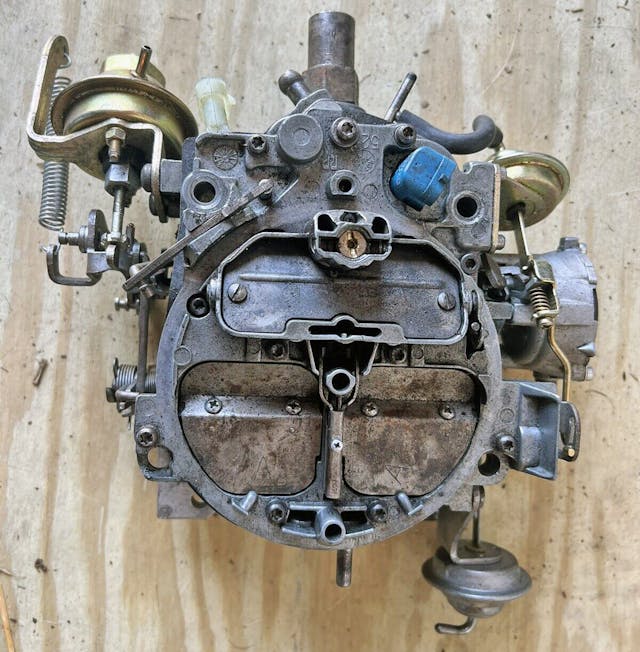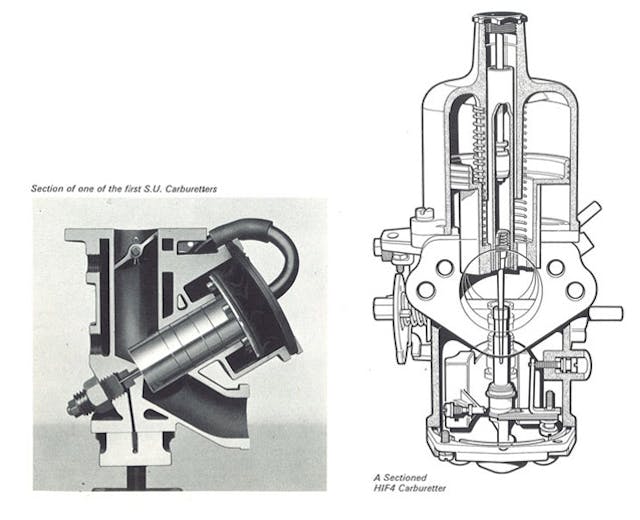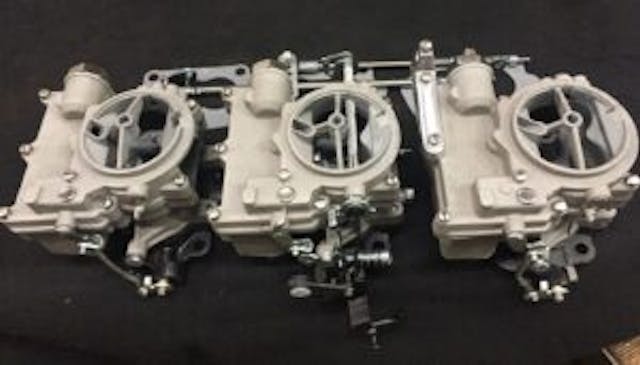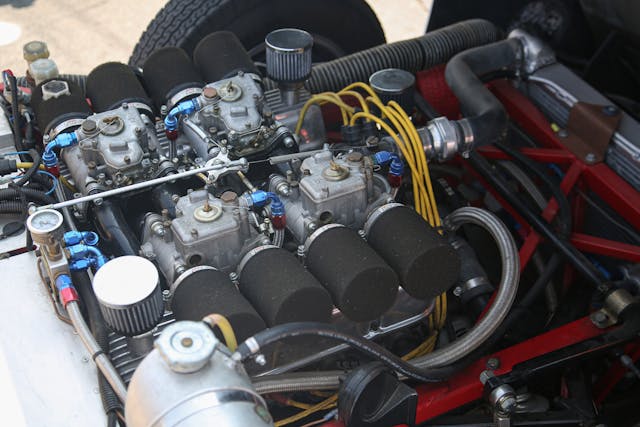Media | Articles
According to You: The most loved/hated carburetor induction system?
We asked about induction systems of the carbureted variety, and you gave us the systems that bring home the bacon. Or not, as some of them were the opposite of smashing success. But that’s the joy in Hagerty’s According to You, as we wanted your unvarnished feedback on carburetor induction systems, be it good or bad.
So let’s see what the Hagerty Community came up with, for better (like a Holley) or worse (like a Chrysler Lean Burn)!
Weber Love
@Ryan: A roommate in the ’80s had a Sunbeam Tiger with a built 302 and 4x downdraft 2v Webers on a Cobra manifold. Stacks and screens, no filters. The intake noise raised hair on one’s neck.
@Jonathan: My favorite setup is the dual Weber 48 IDA’s on a VW Beetle engine.
@David: How about replacing my “Most Hated” fuel system with what quickly became my “Most Loved” fuel system?
I bought a Platinum Metallic 1980 VW Scirocco in 1981. Dude had put 50K miles on it in that one year by doing a long interstate commute in it every day. If not, I would have never been able to afford it. Shortly after buying the car, I followed two friends to an SCCA autocross event about 50 miles away. One friend drove his 911 SC and the other his 914-6. It was all I could do to keep them in sight. Luckily, they were kind and I managed to stay within sight. So I got there, registered, and did a couple runs. There was another Scirocco there. It was outwardly identical except red, and he was besting my times by a significant margin. Now, I’m not saying I was some kind of driver hero, but this was not my first autocross (just my first one in this car). So I introduced myself and asked how he was so much faster around the cones than I was. He popped the hood and pointed to a pair of Weber side drafts. He said, “Throw everything K-Jetronic into the garbage and get you a pair of these.”
I found a used pair and did just that within the month. BOOM. I was amazed at the transformation the car went through with that one upgrade. Of course, that was just the start. Over the next couple years there was a decent cam, a header, upgraded suspension, rally lighting, stereo, window tint, etc. Loved that car.
@Tim: I’m pretty sure this won’t count, but I had a ’69 Opel GT purchased from a friend. It had been upgraded from the factory carb to a pair of Weber 45DCOE side draft carbs. Really gave that car a boost in power. The car had a lot of body mods as well—targa roof, extended rear end, wide body fender flares integrated, etc. My only regret is that I was older and had more funds to sort it all out. The interior needed an overhaul and it needed some other work as well. I had a dream of making it look like a Dino.
No love lost for this Weber

@Alex: The worst ever is easy: Maserati Biturbo and its Weber carburetor. A fuel system shouldn’t start engine fires so frequently, and putting it under a flammable hood blanket was just an added bonus.
Love the Carter AFB/Edelbrock

@mrhemi: There’s nothing like the dual Carter AFBs on a 426 Hemi properly tuned. Even the FSM tuning and synchronization procedure is a pleasure to perform.
@Donny: I like the Edelbrock we put on my family’s ’67 Firebird. I haven’t had to touch the thing in years. It has never been hard to start. Never has idling issues. Automatic choke works in the cold. No vapor lock when it’s hot and sitting at a light. I installed the thing eight years ago, and it’s just been stone-dead reliable. I checked the plugs a few months ago and they were all clean.
Hate the E4M Quadrajet

@Oversquare+Bore: I grew up in the late ’70s/early ’80s and saw firsthand the pathetic output of Detroit V-8s (from all the manufacturers). When I was 16, I got a used 1981 Camaro. Then 1981 happened to be the worst of the terrible years for GM products. It was the first year of the computer-controlled carburetor, and 1981 was also in the displacement downsizing era—my 3600-pound Camaro had the 267 -cubic-inch small-block V-8.
Long live the Cross Ram

@Lash: No love for the old Mopar Cross Ram? Just the mention of Lean Burn gave me a headache.
@Uncle Buck: For sheer WOW factor, I don’t think anything touches the 413 long tube cross ram set up.
Hate the Quadrajet?

@Mike: Try though one might, the Quadra-Bog remains indefensible.
@TG: I’m sure the Quadrajet will come up in this discussion as the worst, junkiest carburetor out there. However, it has been my general experience that 99.2 percent of the people who make that statement have no idea how to work on a carburetor, took one off of a junkyard motor, slapped it on theirs … and expected it to just work!
@Marc: The problem with the Quadrajunk was the metering rods. If a heavy-handed (person) didn’t carefully assemble the carb, the metering rods would get bent. I learned that the hard way.
@DUB6: We had one that was both most loved and most hated at the same time. Back in the mid-’60s, when a couple of friends and I were pretty seriously getting into stoplight drag racing, my buddy got hold of a ’55 Nomad that purportedly had a “built 265” (whatever that meant—we were way too young and none too smart) with a cross-ram and two Rochester Quadra-Jets. Looking back, it was a totally weird combination, but at the time, it was just impressive when we opened the hood. We weren’t able to identify whether it was a 265 or a 283 (online numbers researching was years away, and honestly, who cared; telling someone whose doors we’d just blown off it was “just a 265” was priceless), but that SBC had some sort of hurky cam, and for the most part, all that carburation wasn’t too much for it.
But it was heck to both tune and keep that way. We’d get it to go great guns at WOT, but it wouldn’t idle. Then we’d get it to idle, and it’d stumble about halfway through the powerband. But when it all clicked, it was really a terror for a heavy car with not much engine—just one of those freakishly quick cars that sometimes happened.
Love the Quadrajet?

@Tinkerah: A clean, leak free Q-Jet is as cheap, well performing, and reliable as you can get.
@Bob: Q-Jets were a great street strip carb. Plenty of tuning parts: Jets, metering rods, springs, secondary rod hangers, idle emulsification tubes, well seals, etc.—you name it. The days of carbs may be over but not forgotten. I still have four or five on the shelf.
@Peter: Loved the Q-Jets! I tricked-out many carbs in SoCal in the mid-’60s and early ’70s for friends, relatives and myself. My favorite to trick-out and the most to respond were the GM Quadra-Jets. Decent fuel economy on the small primaries, but open up the throttle and when the giant secondaries open the car will launch! Had a ’67 HO GTO and ’70 Ram Air IV GTO and experimented with different carb systems, including a 1966 GTO Tri-Power set up, a 1000 cfm ThermoQuad, two Carter AVS’s (dual quad), Holly 850 Double Pumper, etc., etc., but I went back to the Q-Jets for best overall performance.
I liked the Pontiac over the Chevy Q-Jets for one reason: Pontiac carb fittings had longer threads; also the inlet was in-line as the Chevy’s were off at 90 degrees. Also Chevy carbs had lesser quality as the castings crumbled easier, bottom fuel bowl plugs leaked, etc.
@Jim: I’m an Olds man, so Q-Jets are a way of life, and my favorite. Invariably, when I had a bad running Q-Jet, it was either an original in need of a rebuild or most likely had already been rebuilt by someone who should have their screwdriver operators license revoked.
Q’s have some well known issues, such as leaking fuel bowl welch plugs, worn throttle shafts, bad choke pull-offs, etc. Most home re-builders do not fix any of the known issues (or even know of them), but the owners will say, “I rebuilt it and its still junk.” They then go out and buy a new anything and say how much better it is then a Q!
@Ryan: Q-Jet is a wonderful carb when matched with the motor/trans/hearing and tuned properly. And with the air cleaner lid flipped, makes the most awesome intake “AH-OOOOO” noise. My high school ’67 Impala SS 396/350 had a Quadrabog. But it didn’t, because my uncle knew carbs: no bog, just ah-ooo!
@Daniel: I have two Pontiacs with original equipment Q-jets. The ’69 GTO Ram Air III carb has not been off the motor since I bought the car in 1996! The ’68 Firebird 350 HO carb has not been off the motor since at least 2002 when my brother bought it from the original owner; I have owned it for five years. I also ran Q-jets on my 455 Olds-powered jet boats for many years.
Correct calibration is challenging if adapting a non-original carb. Now the malaise era: I bought a ’75 Camaro LT in 1980, and I could not get the jets and rods to calibrate in the Q-jet, so I mounted an 1850 Holley, recurved the HEI ignition, and it ran great with improved gas milage as well.
All Hail Holley
@Oscar: Have always had good luck with Holley carbs. I am running a modified 390 on a blown Chevy 3.2L, 60-degree V-6 in a 1800# hot rod right now and it runs great!
@Dean: I am partial to the Holley Double Pumper, mainly because I had two old Novas with this carb and have learned how to tune them. Our current ’63 Nova SS has a 350, solid flat tappet cam, Holley cylinder heads, Edelbrock Performer RPM intake, and M20 Muncie four-speed and 750 double pumper. Runs like a champ, makes good power, and gets reasonable fuel economy. I know darn well though that swapping the intake and carb to a Quadrajet would net me better fuel economy and likely better throttle response. As others have said, the Quadrajet is a great carb if tuned properly.
@Gerald: Yep, Quadrajets were terrible, but Holley came up with an easy fix called a “Spread-Bore” that bolted directly onto the GM manifold. My ’68 Corvette 327/350 ran beautifully after the switch. Amazing how time turns junk into gold. Many years later, someone paid $50 for the old Quadrajet at a garage sale.
Support Skinners Union!

@Stuart: Why no mention of true, variable venturi, constant-vacuum carburetors? In particular, SU: This is a brilliant design of true engineering elegance. With its continuously-variable fuel metering matched to venturi opening, it is the transition design between carburetors (or carburettors) and throttle-body fuel injection.
In the hands of a moderately-experienced person, they are dead-easy to tune. And, they stay that way for a long time. Unfortunately, all too often, some ignorant clod got his mitts on them and then they usually didn’t perform well. That’s how they got a bad rep in the U.S.
@Isaiah: I have SU carbs on an MGA and think they’re simple and easy … but man, you should hear the weird comments I get. People seem to hate them. I had the Weber downdraft replacement on a MGB, and you couldn’t dial out the dead spot before the secondaries: if you check the MGB forums you’ll see it’s a known and accepted feature, so I never understood why Webers were better than SUs.
Malaise for good reason?

@David: My least favorite? Any of that malaise-era equipment. Lean-burn? Shudder.
All were necessary steps to get us to the modern era, but if you have to make make that stuff work to register your car (say, in California) it’s a real hassle.
Rochester Tri-Power

@Calvin: My favorite is the ’66 Pontiac GTO with the three Rochester two-barrel carbs. This tri-power setup is super cool and makes as much power as a big Holley carb but runs as a two-barrel until you need more juice.
@JeffS: The ’65 and ’66 versions used a mechanical linkage for carbs 1 & 3 (with the center being the primary), and worked well. The ’64 version used a vacuum system for the secondary carbs, which was a terror. An induced (think turbo lag) pause between hitting the gas and making power, and the scary part, letting off the gas with limited vacuum (wide open throttles) created a longer delay in slowing down the motor.
Annoying at the “go” part, terrifying at the “whoa” command, especially with those four-wheel drum brakes. Most ’64 setups I’ve seen were upgraded to mechanical linkage, at least the ones that survived. Lots of underhood roar with air flowing through those three tiny air cleaners (with shiny chrome covers).
@Tinkerah: I love the Tri-Power on my T-Bucket. Exposed engine maximizes the visual impact. Halfway into the pedal, you’re suddenly pushing against three times as many return springs and the power REALLY starts coming on. Contrary to all the rumors you hear about how difficult they are to set up from blowhards with no experience, they are the easiest in all of mine.
Anything side draft
@David: My favorite form of induction is multiple side draft carburetors (or ITBs, in my case) with no air box and exposed velocity stacks. Weber, Dell’Orto, Solex, Mikuni—whatever is used, they look amazing and sound even better.
So, how did the Hagerty Community do? What carbs did we get right, and which ones did we miss?
***
Marketplace
Buy and sell classics with confidence
Check out the Hagerty Media homepage so you don’t miss a single story, or better yet, bookmark it. To get our best stories delivered right to your inbox, subscribe to our newsletters.























I have a 60 year old Corvette with a 327\ 300 with a 4barrel Rochester
I have owened for 24 years.
Always runs. Great
Many years back I raced a special saloon Mini which was trick in every department and that sported a pair of split Webers, one choke on each carb blanked off to get the straightest route to supply fuel to its 1300cc Swiftune engine. An ingenious solution.
No one mentioned the Thermoquad other than the Lean burn. They have to be the best Love – Hate or better yet, Hate – Love
The Zenith 2 bbl. that was fitted to 1975 -1976 VW Rabbit and Scirocco. In my 30+ years as a professional auto mechanic that
was, far and away the worst
design I ever suffered the indignity of having to work on.
I always told my customers who
owned these cars that once the factory warranty expired, replace the Zenith with a Weber DGV-5A.
My oh my, what a difference when the engine can finally draw a deep breath.
What? No mentions about the ol’ Stromberg 97? I guess I’m getting old!
The Infamous SU (Stewart Union) carbs were a mystery to many. I had an Austin Healey 3000 Mk 2 with three 1 1/2″ SUs which Austin fitted to homologate the model for international rallying. A British friend showed me the trick. With the air cleaners removed and the car idling at a steady 1000 rpm listen to the air suction sound at each intake using a hollow tube. Adjust the idle screw of each carb until they sound the same and the idle is smooth. I used an a half inch aluminium tube about a foot long and never had a problem in 5 summers with that car.
Dual Predators on the 66 with 632 and 4 DCOE’s on the 327 67 Chevy Roadsters.
No one mentioned how dreadful anything in the early ’70s with the exhaust gas recirculation could be. I hat a ’72 Opel Rally with the terrible Solex carbuetor, EGR and an old system points and condenser. It was a superb car in so many ways, but the engine couldn’t keep up with the suspension. I added a Weber carb with a K&N filter, a Motorola electronic ignition, a set of Bilstein shocks and fat Pirelli’s. I spent many an enjoyable evening carving up the mountain roads and embarrassing the guys who didn’t know how to drive a 911.
I can’t recall if any of the Holley carburetor books and articles that I have read ever mention a needle and seat issue that I have experienced over the years (even in pre-ethanol days). When new and dry, the viton needle tip is fairly hard. After being exposed to fuel for several days, the tip softens which changes the float level – and completely ruins tuning and driveability. If you don’t have tools, it can be very difficult to get the car home as it spits and bucks. After the float level is corrected and if the car is driven more often than every 3-4 months, the problem is gone. But if a car is stored for the winter, chances are good that the needle tips will dry out again. My accommodation in the Spring was to fill the bowls through the vent tubes and let it sit for a couple of days. The tips softened and it was ready once again for road use. I think this rarely discussed problem may be why a lot of Holley carbs are declared “junk”. Yes, I never liked this extra fussing around, but my Holley carbs worked great after doing it.
Back in the 80’s I purchased a 77 MGB. Fun car but the single Stromberg was terrible. After spending countless hours fiddling with it, I drove over to Pat Goodman’s shop in Winchester Va. I asked Pat if he had a fix for it, he muttered a few obscenities, (that was Pat). I followed him to a storage room that felt like a dungeon.
On a ratty primitive wooden shelf was an old style manifold with two HUGE SU’s. They didn’t look normal so I asked Pat. “They’re off a Volvo dummy. MUCH bigger.” “Will I have any trouble making the swap” I inquired.
“not really, but it won’t idle very well cause everything has been polished and ported” I didn’t know exactly what that all meant at the time but off I went with my new purchase. (Pat muttered something like “HAVE FUN”)
At home my father helped me swap out the manifold and carbs. After a short time of fiddling with the mixture, I told my father to move the MGB from the backyard to the driveway. He dutifully dropped the clutch and the MGB cut the most amazing 50 foot rut in the yard (rooster tail of soil and sod) He finally got it stopped before he created a gate in the neighbor’s fence. My father jumped out and started screaming about how dangerous that car had become.
During his fit of anger, I don’t think he was aware of the gigantic smile on my face. We (with Pat’s help) had transformed the slow and pathetic MGB into a MONSTER. (Really enjoyed that car)